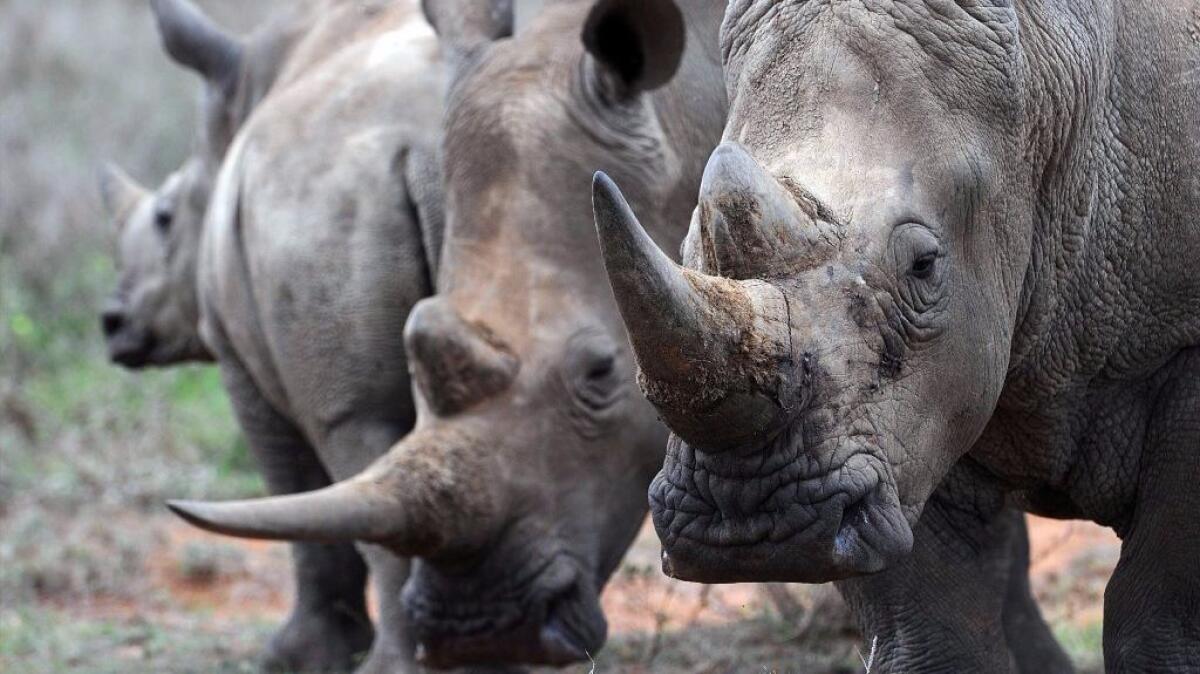Scientists discover that white rhino dung has a lot in common with a Facebook post

Here’s a social networking site you can find with your nose. Scientists studying the communal pooping areas of white rhinos in South Africa have found that the animals use them like social messaging boards — to leave notes about their status and to read the “posts” of others.
The discovery, published in the Proceedings of the Royal Society B, offers insight into the behaviors of these and other social animals — and could even help researchers develop new tools to aid in their conservation.
Mammals are known to leave one another scent signals in their urine (as anyone watching a dog studiously sniff a lamppost while his owner tugs on the leash might suspect).
But the potential signal-sending power of poo has garnered relatively less attention, scientists said.
“Urine has been more heavily studied,” lead author Courtney Marneweck, an ecologist and doctoral student at the University of KwaZulu-Natal in South Africa, said in an email. “Perhaps because the behavior of urine marking is so obvious (i.e. it normally comes via urine spraying), its function is obviously more than pure elimination. Because specific behaviors are less common when defecating, perhaps the communicatory significance was unrealized.”
But scientists have begun to suspect that dung may actually play an important role in social communication — especially for animals like the Oribi antelope, the coyote and the white rhinoceros, which uses communal defecation sites (also known as ‘middens’).
“From behavioral observations we were really sure that rhinos were using middens to gather information about each other,” Marneweck said. “This was first noticed by [South African researcher] Norman Owen-Smith in the early 1970s. But only recent developments in technology have allowed us to really understand odors.”
There were several reasons white rhinos were the perfect study subjects, Marneweck said.
“White rhinos are a great model species to study olfactory communication (that’s communication via smell),” she wrote. “Firstly, they have very bad eyesight and rely on olfaction heavily. Second, the middens that they use are large (up to 20 meters in diameter), frequent, and really easy to find.”
The plan was to gather dung immediately after a rhinoceros relieved itself. That way researchers would know exactly which individual deposited each sample, which would allow them to figure out whether there were any telltale chemicals that correlated with that animal’s identifying characteristics (like sex or age).
Finding these smelly, sizable middens may have been easy — but catching a rhino in the act was no walk in the park, she added.
“Field work is always challenging, but collecting all this data took a long time…. I think my record for waiting for a rhino to poo was 7.5 hours!” Marneweck wrote. “That’s after walking and tracking it!”
After sampling the volatile, or airborne, chemicals from 150 dung samples, she used a pattern-recognition algorithm to figure out the “smell profiles” of each animal in terms of sex, age, territorial state (for males) and whether they were in heat (for females).
(For those who are curious: According to the study, 2,3-dimethylundecane signaled an animal’s sex, heptanal revealed its age group, nonane indicated a male’s territorial status, and 2,6-dimethylundecane revealed whether a female was in heat.)
Once she and her colleagues knew which airborne chemicals correlated with each characteristic, Marneweck created a faux deposit for a territorial male and a female in heat (known as an “estrous female”) and put them in the field to see what effect they had in the wild.
Sure enough, when a territorial male smelled the estrous female, he sniffed the source for a long time and then went to track her down. But if he smelled a territorial rival, he immediately became vigilant and then tried to search out the threat. (Smelling non-dominant males and non-estrous females didn’t seem to matter to the territorial male.)
The findings show that rhinoceroses really do leave very specific “posts” about themselves at these middens that help drive the local population’s social activity.
There’s a good reason to use urine and dung to deliver these messages, Marneweck pointed out — it doesn’t cost any extra energy to do so.
“Using a waste product for a scent marking signal is energetically smart,” she said. “It is costly for animals to create specialized scent secretions, but urine and dung require no extra energy costs. Dung is larger and therefore easier to find, but the longevity of dung vs. urine is species-specific.”
Plenty of other animals, both plant- and meat-eaters, use such communal pooping grounds – and identifying the telltale compounds in their dung could open a new door to studying them as well as to creating new tools for land management and species conservation.
“For example, encouraging animals to cross a corridor to increase genetic flow, or discouraging animals from dangerous areas such as human conflict zones,” Marneweck said, noting a few of the possibilities. “There are even captive applications such as aiding breeding programs by providing olfactory stimuli.”
Follow @aminawrite on Twitter for more science news and “like” Los Angeles Times Science & Health on Facebook.
MORE IN SCIENCE
Rallying support for economic fairness? Better chase off the needy
Meet the ‘Hidden Figures’ mathematician who helped send Americans into space
Seven science stories we can’t wait to follow in 2017





